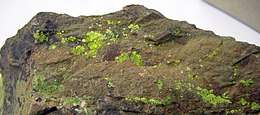Tangeite
Tangeite, also known as calciovolborthite, is a calcium, copper vanadate mineral with formula: CaCu(VO4)(OH). It occurs as a secondary mineral that can be found in sandstone and also in the oxidized zones of vanadium bearing deposits.
| Tangeite | |
|---|---|
 | |
| General | |
| Category | Phosphate mineral |
| Formula (repeating unit) | CaCu(VO4)(OH) |
| Strunz classification | 8.BH.35 |
| Dana classification | 41.05.01.06 |
| Crystal system | Orthorhombic |
| Crystal class | Disphenoidal (222) H-M symbol: (2 2 2) |
| Space group | P212121 |
| Unit cell | a = 7.45 Å, b = 9.26 Å c = 5.91 Å; Z = 4 |
| Identification | |
| Color | Yellow, yellow-green, olive green, green to dark green |
| Crystal habit | Rarely as short prismatic crystals, commonly as fibrous to botryoidal encrustations |
| Cleavage | Perfect on {010}, good on {001} |
| Tenacity | Brittle |
| Mohs scale hardness | 3.5 |
| Luster | Vitreous, pearly on cleavage faces |
| Streak | Light yellow green |
| Diaphaneity | Transparent, Translucent |
| Specific gravity | 3.75 - 3.84 |
| Optical properties | Biaxial (-) |
| Refractive index | nα = 2.010 nβ = 2.050 nγ = 2.090 |
| Birefringence | 0.08 |
| 2V angle | 83° (measured) |
| References | [1][2][3] |
It was named in 1925 by Aleksandr Evgenievich Fersman for its discovery locality in the Tange Gorge, Ferghana Valley, Alai Mountains, Kyrgyzstan.[1]
References
This article is issued from Wikipedia. The text is licensed under Creative Commons - Attribution - Sharealike. Additional terms may apply for the media files.